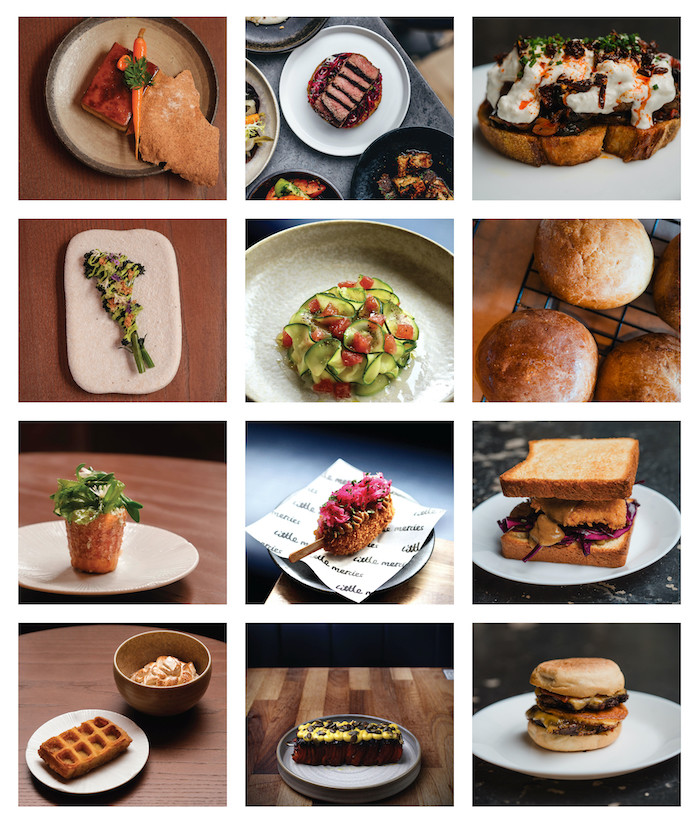
Once the domain of salty nibbles, bars have become a melting pot of small-plate creativity as owners recognise the opportunity of an edible offering. By Ellen Manning
The nights of questionable nuts and olives are drawing in. Bars are starting to show the same ambition with bar food as their drinks, making it an integral part of their venue’s experience. The result is a hybrid of restaurant-standard food in the bar, where place settings are more casual, customers want less formality, and the food comes out of small kitchens.
More and more when you ask new bar owners about their food ambition there’s a running theme: no longer are bartenders fearful of food. At Birmingham’s Passing Fancies, founder Eve Green – who stepped into the breach when the bar lost its chef just before opening – wanted to create a menu based on what she liked. “One of my favourite things is small plates, and we thought if we could emulate and recreate that in a bar setting it would give a pull.” At London’s Kwant, the need to serve food started as a license requirement, but owner Erik Lorincz wanted to push further. “I didn’t just want to put on cheese or meat boards to tick a box. If we’re pushing the boundaries on the cocktail element, I thought why don’t we do the same thing with the food?”
But while ambitions are high, it’s not as simple as replicating restaurant food. Practicality rules, which explains why small plates are a common route – produced quickly and easily, and simple for customers to enjoy alongside drinks. Lorincz gave his chef carte blanche to create dishes aligned with Kwant’s ethos, on the proviso they could be served simply, as finger food or with minimal cutlery, and produced at volume in a limited space by one person. “I didn’t want to serve dishes that were complicated or required a full table setting because that slows down the service. Our kitchen is small, which means he’s often by himself. so the dishes need to be tasty but easy to execute. And when we place them on the table, they don’t take up too much space.”
The same goes for practicality behind the scenes. “We don't have heat lamps in the kitchen, and we are very much a wet-led venue, so we have to take these things into consideration,” says Alan Frost, owner of Little Mercies in London. “We need to ensure we have very low-wastage dishes, and work cleverly to create things that can be stored but are still super-high quality. Our dishes also come out when they are ready, and they can’t sit on the pass, so that means we have to build a menu where some items are almost instantly ready, and some take longer, allowing guests to work through plates without being overwhelmed.” None of that means they can’t get creative, and they still have a comprehensive array of equipment, from standard cookers to kit that can be used by both bar and kitchen, such as a Rotovap, which helps push creativity as well as limiting waste.
Complementing the drinks offer
But does adding chef-cooked dishes blur the purpose, taking away the focus from wet-let venues? Green thinks not, finding decent food encourages people to stay longer - ultimately probably buying more drinks. And Steven Diaz, head chef at Tayer + Elementary, points out that the food menu doesn’t ignore the drinks, but often complements them. In Frost’s view, the biggest limiter isn’t the practical side of things, but guests’ mindset. “We aren’t a classic restaurant, we don’t have table settings, we have high tops and people eat at the bar. So, there is a very different picture in people’s minds about what sort of food we will serve, and what they want to eat.”
That shift in perception is likely to come, with many people embracing the chance to eat and drink in the same venue. Plus, there are other benefits for the bars offering food. For Green, her time in the kitchen taught her lessons in flavour and technique that she’s taking back behind the bar to her drinks. Recently, a decision to hire chef Aidan Hynes has also allowed Passing Fancies to add brunch and breakfast to its offer – unusual for a bar, but popular so far. And at Kwant the success of its menu has seen it develop a seven-course tasting menu experience that’s already a hit.
The result of the same innovation and creativity that produces some of the best drinks in the world is a bar food scene that is a unique mix of restaurant quality designed specifically for this kind of setting. Which means for many of us, the times of ‘dinner then drinks’, or vice versa, are long gone. Now it’s ‘drinks and dinner’ all in one place, and barely an olive or nut in sight.
Photos: Left column: Kwant. Central column: Little Mercies. Right column: Passing Fancies


